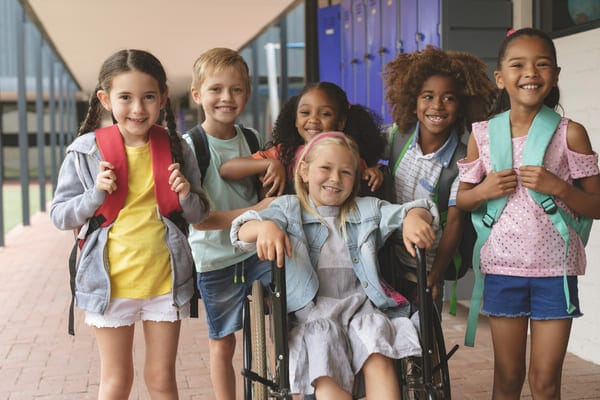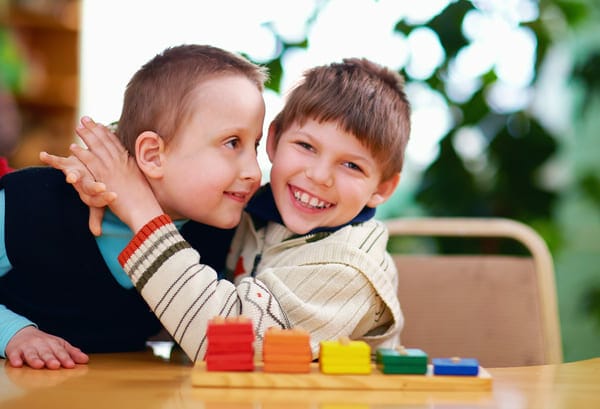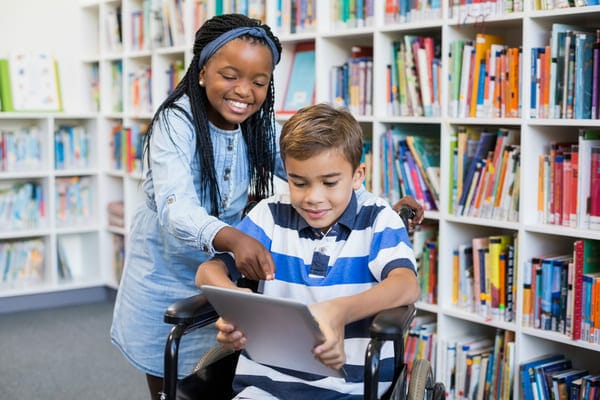
According to the United States Census Bureau, the percentage of children with a disability in the United States has increased from 3.9 percent to 4.3 percent between the years 2008 and 2019 (US Census Bureau, 2022). The increase is likely due to a number of factors, including improved family access to care, greater public awareness, and increased acceptance of disabilities. This means that most children will encounter a disabled peer at some point in their lives, making early conversations about disability acceptance critical. By welcoming children’s curiosity and questions about disabilities, we can foster empathy, respect, and inclusivity.
Discussing the topic of disability at home can be a challenging task for some caregivers, especially if they have had limited interactions with the disabled community. This difficulty might stem from lack of knowledge about disabilities, which can lead to a fear of unintentionally saying the wrong thing. However, approaching this topic doesn’t have to be complex, and it’s actually a great opportunity to address any misconceptions your kids might have. While it’s important to acknowledge disability as part of an individual’s identity, it is also equally important to celebrate and normalize one’s unique abilities, even if they might differ from our own.

Avoid presuming that a person with a disability would not be willing to talk about their disability experience with your child. Many members of the disabled community are often eager to share their stories in an effort to promote awareness. Similarly, if your child asks questions about adaptive devices or equipment that you are unfamiliar with, use this as an opportunity to learn together! Be sure to utilize proper names when referring to mobility or communication aids, refraining from creating your own titles. By using appropriate terminology, we can promote a shared understanding and foster inclusivity among everyone when discussing assistive technologies.
Imagine yourself in a situation where your child’s curiosity leads them to stare at someone or their device. Instead of reprimanding their actions, use this as an opportunity for your entire family to learn. You can say something like, “I noticed you’re checking out that person’s wheelchair, pretty cool, right? Their wheelchair is what helps them get around the city, just like our legs!” By providing simple explanations and refraining from language that depicts another individual as “different,” you are successfully teaching your child disability inclusion and acceptance. You can also explain that these devices help people with disabilities access the same information or experiences as everyone else!

While we’re on the topic of language, let’s talk about disability terminology. It’s important to use language that is respectful and accessible to everyone, regardless of ability. This includes avoiding ableist language and using person-first language when appropriate. In the past, there was the assumption that individuals with disabilities preferred non-disabled people to use “person-first” language (e.g., “person with a visual impairment”). However, terminology preferences vary depending on the person, so it’s always best to ask for clarification if you are unsure. By modeling respectful behavior, we are normalizing inclusion and acceptance for future generations. If you don’t make a big deal about disability or treat it as different, your child likely won’t either.
It’s also important to remind your children that not all disabilities are necessarily “visible.” For example, there might be a student in your child’s class who is a total communicator, meaning they do not communicate verbally or might utilize alternative methods of communication, such as a speech generating device. If your child notices someone with a communication device you can offer a positive explanation like, “That device helps them be understood, just like how we use our voices! Isn’t it amazing how many ways technology can help us?” We can educate our children on other ways to communicate and engage with their peers, such as through play, body movement and posture, gestures, and more!
In summary, teaching children empathy and inclusion from an early age is crucial for creating a more equitable future for all. By having open and positive discussions about disabilities and encouraging our children’s questions and genuine curiosity, we can help break down stigmas and societal barriers faced by the disabled community. It is our responsibility to continue working together to raise future generations who value diversity and celebrate all abilities.

For additional resources visit:
- Becoming a Conscious Communicator: A Clinical Fellow’s Journey
- An Evolving Mindset: Person-First vs. Identity First Language
- The ABCs of Inclusion: A Disability Inclusion Book for Kids
- Wiggles, Stomps, and Squeezes Calm My Jitters Down
- Able Fables Book Co.
- Kids on the Block Puppets: Acceptance of Differences in Self and Others
References:
- US Census Bureau. (2022). Childhood Disability in the United States: 2019. Census.gov. https://www.census.gov/library/publications/2021/acs/acsbr-006.html
- Including Children with Disabilities in Connecticut Early Childhood Programs. (n.d.). https://portal.ct.gov/-/media/SDE/Special-Education/Early/InclusionFlier.pdf

